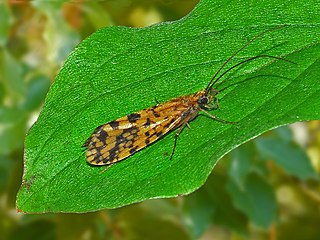
Aquatic insects or water insects live some portion of their life cycle in the water. They feed in the same ways as other insects. Some diving insects, such as predatory diving beetles, can hunt for food underwater where land-living insects cannot compete.

The caddisflies, or order Trichoptera, are a group of insects with aquatic larvae and terrestrial adults. There are approximately 14,500 described species, most of which can be divided into the suborders Integripalpia and Annulipalpia on the basis of the adult mouthparts. Integripalpian larvae construct a portable casing to protect themselves as they move around looking for food, while annulipalpian larvae make themselves a fixed retreat in which they remain, waiting for food to come to them. The affinities of the small third suborder Spicipalpia are unclear, and molecular analysis suggests it may not be monophyletic. Also called sedge-flies or rail-flies, the adults are small moth-like insects with two pairs of hairy membranous wings. They are closely related to the Lepidoptera which have scales on their wings; the two orders together form the superorder Amphiesmenoptera.

Aquatic biomonitoring is the science of inferring the ecological condition of rivers, lakes, streams, and wetlands by examining the organisms that live there. While aquatic biomonitoring is the most common form of biomonitoring, any ecosystem can be studied in this manner.

The Annulipalpia, also known as the "fixed-retreat makers", are a suborder of Trichoptera, the caddisflies. The name of the suborder refers to the flexible terminal segment of the adult maxillary palps, which often has many tiny rings.

Helicopsychidae are a family of Trichoptera. The name refers to the helix shaped larval cases and they should not be confused with Limnephilidae which sometimes inhabit the snail shells. Their shells range from 6–8 millimetres (0.24–0.31 in) and are crafted from mineral grains. Their typical habitat is in slow-flowing water in ditches. Helicopsychidae larvae have a comb-like anal hook. Helicopsychidae is divided into two extant genera, Rakiura and Helicopsyche, and two fossil genera Electrohelicopsyche and Palaeohelicopsyche. The family contains more than 270 species and are present on all major faunal regions.

The Ecnomidae are a family of caddisflies comprising 9 genera with a total of 375 species.

The Psychomyiidae are a family of tube-making caddisflies. Members of this family are typically very similar to polycentropodids, most of them can be differentiated by the spur formula is 2-4-4, thyridial cell short, absence of the forewing fork I, and hindwing forks I and IV. Male genitalia has elongate preanal appendages, and reduced tergum IX. The larvae differ by the submental sclerites separated, foretrochantin broad, and the pupal mandible apex whip-like. Larvae construct long silken galleries.

Philopotamidae is a family of insects in the order Trichoptera, the caddisflies. They are known commonly as the finger-net caddisflies.
The Glossosomatidae are a family of the class Insecta and order Trichoptera.The family contains 23 genera in three subfamilies. In the US alone, there are 76 spp. in 6 different genera.
Dolophilodes distinctus is a species of caddisfly in the Philopotamidae family. The larvae are found in streams in eastern North America where they build net-like retreats.

Uenoidae is a family of stonecase caddisflies in the order Trichoptera. There are about 7 genera and at least 80 described species in Uenoidae.
Smicridea is a genus of netspinning caddisflies in the family Hydropsychidae. There are more than 210 described species in Smicridea.
Dicosmoecus gilvipes is a species of northern caddisfly in the family Limnephilidae. This particular caddisfly is found in and near streams of North America, from northern California and Colorado to British Columbia and as eastern to Nevada, Idaho, Montana and Alberta. D. gilvipes is commonly known as the October Caddis, Autumn Caddis or Giant Orange Sedge, due to their flying presence acknowledged in the Autumn. Caddisflies are known to build cases when they are in larvae stages, to protect themselves from predators, such as dragonflies, salmon and trout. The October Caddisfly is no different and builds their cases out of different organic materials during their five larvae stages.

Arctopsyche is a genus of netspinning caddisflies in the family Hydropsychidae. There are more than 20 described species in Arctopsyche.
Parapsyche is a genus of netspinning caddisflies in the family Hydropsychidae. There are more than 20 described species in Parapsyche.

Diplectrona is a genus of netspinning caddisflies in the family Hydropsychidae. There are more than 100 described species in Diplectrona.
Homoplectra is a genus of netspinning caddisflies in the family Hydropsychidae. There are about 11 described species in Homoplectra.

Potamyia is a genus of netspinning caddisflies in the family Hydropsychidae. There are more than 20 described species in the genus Potamyia.

Philopotamus montanus, common name yellow spotted sedge, is a species of caddisfly belonging to the family Philopotamidae.















